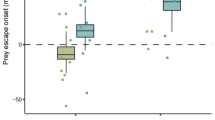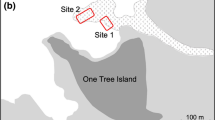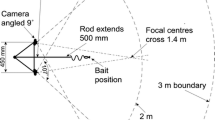Abstract
Water motion is an important factor affecting planktivory on coral reefs. The feeding behavior of two species of tube-dwelling coral reef fish (Chaenopsidae) was studied in still and turbulent water. One species of blenny, Acanthemblemaria spinosa , lives in holes higher above the reef surface and feeds mainly on calanoid copepods, while a second, A. aspera , lives closer to the reef surface, feeds mainly on harpacticoid copepods, and is exposed to less water motion than the first. In the laboratory, these two blenny species were video recorded attacking a calanoid copepod ( Acartia tonsa, evasive prey) and an anostracan branchiopod (nauplii of Artemia sp., passive prey). Whereas A. spinosa attacked with the same vigor in still and turbulent water, A. aspera modulated its attack with a more deliberate strike under still conditions than turbulent conditions. For both fish species combined, mean capture success when feeding on Artemia sp. was 100% in still water and dropped to 78% in turbulent water. In contrast, when feeding on Acartia tonsa, mean capture success was 21% in still water and rose to 56% in turbulent water. We hypothesize that, although turbulence reduces capture success by adding erratic movement to Artemia sp. (passive prey), it increases capture success of Acartia tonsa (evasive prey) by interfering with the hydrodynamic sensing of the approaching predator. These opposite effects of water motion increase the complexity of the predator-prey relationship as water motion varies spatially and temporally on structurally complex coral reefs. Some observations were consistent with A. aspera living in a lower energy benthic boundary layer as compared with A. spinosa: slower initial approach to prey, attack speeds modulated according to water velocity, and lower proportion of approaches that result in strikes in turbulent water.







Similar content being viewed by others
References
Almany GR, Baldwin CC (1996) A new Atlantic species of Acanthemblemaria (Teleostei: Blennioidei: Chaenopsidae): morphology and relationships. Proc Biol Soc Wash 109:419–429
Bellwood, DR, Wainwright PC (2002) The history and biogeography of fishes on coral reefs. In: Sale PF (ed) Coral reef fishes: dynamics and diversity in a complex ecosystem. Academic, San Diego, pp 5–32
Buskey EJ, Coulter CJ, Strom S (1993) Locomotory patterns of microzooplankton: potential effects on food selectivity of larval fish. Bull Mar Sci 53:29–43
Buskey EJ, Lenz PH, Hartline DK (2002) Escape behavior of planktonic copepods in response to hydrodynamic disturbances: high speed video analysis. Mar Ecol Prog Ser 235:135–146
Clarke RD (1989) Population fluctuation, competition and microhabitat distribution of two species of tube blennies, Acanthemblemaria (Teleostei: Chaenopsidae). Bull Mar Sci 44:1174–1185
Clarke RD (1996) Population shifts in two competing fish species on a degrading coral reef. Mar Ecol Prog Ser 137:51–58
Clarke RD (1999) Diets and metabolic rates of four Caribbean tube blennies, genus Acanthemblemaria (Teleostei: Chaenopsidae). Bull Mar Sci 65:185–199
Coughlin DJ, Strickler JR (1990) Zooplankton capture by a coral reef fish: an adaptive response to elusive prey. Environ Biol Fish 29:35–42
Drenner RW, Strickler JR, O’Brien WJ (1978) Capture probability: the role of zooplankton escape in the selective feeding of planktivorous fish. J Fish Res Board Can 35:1370–1373
Ferry-Graham LA, Wainwright PC, Bellwood DR (2001) Prey capture in long-jawed butterflyfishes (Chaetodontidae): the functional basis of novel feeding habits. J Exp Mar Biol Ecol 256:167–184
Fields DM, Yen J (1997) The escape behavior of marine copepods in response to a quantifiable fluid mechanical disturbance. J Plankton Res 19:1289–1304
Gardella DJ, Edmunds PJ (2001) The effects of flow and morphology on boundary layers in the scleractinians Dichocoenia stokesii (Milne-Edwards and Haime) and Stephanocoenia michilini (Milne-Edwards and Haime). J Exp Mar Biol Ecol 256:279–289
Greenfield DW, Johnson RK (1990) Heterogeneity in habitat choice in cardinalfish community structure. Copeia 1990:1107–1114
Hamner WM, Jones MS, Carleton JH, Hauri IR, Williams DMcB (1988) Zooplankton, planktivorous fish, and water currents on a windward reef face: Great Barrier Reef. Bull Mar Sci 42:459–479
Hastings PA (2002) Evolution of morphological and behavioral ontogenies in females of a highly dimorphic clade of blennioid fishes. Evolution 56:1644–1654
Hearn CJ, Atkinson MJ, Falter JL (2001) A physical derivation of nutrient-uptake rates in coral reefs: effects of roughhness and waves. Coral Reefs 20:347–356
Helmuth B, Sebens K (1993) The influence of colony morphology and orientation to flow on particle capture by the scleractinian coral Agaricia agaricites (Linnaeus). J Exp Mar Biol Ecol 165:251–278
Hicks GRF, Coull BC (1983) The ecology of marine meiobenthic harpacticoid copepods. Oceanogr Mar Biol Annu Rev 21:67–175
Hobson ES (1991) Trophic relationships of fishes specialized to feed on zooplankters above coral reefs. In: Sale PF (ed) The ecology of fishes on coral reefs. Academic, San Diego, p 69–95
Hwang J-S, Strickler JR (1994) Effects of periodic turbulence events upon escape responses of a calanoid copepod, Centropages hamatus. Bull Plank Soc Japan 41:117–130
Hwang J-S, Costello JH, Strickler JR (1994) Copepod grazing in turbulent flow: elevated foraging behavior and habituation of escape responses. J Plank Res 16:421–431
Jackson RR, Wilcox RS (1998) Spider-eating spiders. Am Sci 86:350–357
Jones GP (1987) Competitive interactions among adults and juveniles in a coral reef fish. Ecology 68:1534–1547
Kerfoot WC, Kellogg DL Jr, Strickler JR (1980) Visual observations of live zooplankters: evasion, escape and chemical defenses. Am Soc Limnol Oceanogr Spec Symp 3:10–27
Kiflawi M, Genin A (1997) Prey flux manipulation and the feeding rates of reef-dwelling fish. Ecology 78:1062–1077
Kiørboe T, Visser A (1999) Predator and prey perception in copepods due to hydromechanical signals. Mar Ecol Prog Ser 179:97–111
Kotrschal K, Lindquist DG (1986) The feeding apparatus in four Pacific tube blennies (Teleostei: Chaenopsidae): lack of ecomorphological divergence in syntopic species. PSZNI Mar Ecol 7:241–253
Landry F, Miller TJ, Leggett WC (1995) The effects of small-scale turbulence on the ingestion rate of fathead minnow ( Pimephales promelas) larvae. Can J Fish Aquat Sci 52:1714–1719
Landry MR (1978) Predatory feeding behavior of a marine copepod, Labidocera trispinosa. Limnol Oceanogr 23:1103–1113
Lenz PH, Hartline DK (1999) Reaction times and force production during the escape behavior of a calanoid copepod Undinula vulgaris. Mar Biol 133:249–258
Lough RG, Mountain DG (1996) Effect of small scale turbulence on feeding rates of larval cod and haddock on stratified water on Georges Bank. Deep Sea Res 43:1745–1772
Luecke C, O’Brien JO (1981) Prey location volume of a planktivorous fish: a new measure of prey vulnerability. Can J Fish Aquat Sci 38:1264–1270
MacKenzie BR, Kiørboe T (2000) Larval fish feeding and turbulence: a case for the downside. Limnol Oceanogr 45:1–10
MacKenzie BR, Miller TJ, Cyr S, Leggett WC (1994) Evidence for a dome-shaped relationship between turbulence and larval fish ingestion rates. Limnol Oceanogr 39:1790–1799
Nemeth DH (1997) Modulation of attack behavior and its effect on feeding performance in a trophic generalist fish, Hexagrammos decagrammus. J Exp Biol 200:2155–2164
O’Brien WJ (1979) The predator-prey interaction of planktivorous fish and zooplankton. Am Sci 67:572–581
Ohman MD (1988) Behavioral responses of zooplankton to predation. Bull Mar Sci 43: 530–550
Reaka-Kudla, ML (1997) The global biodiversity of coral reefs: a comparison with rain forests. In: Biodiversity. II: Understanding and protecting our biological resources. Joseph Henry, Washington pp 83–108
Saiz E (1994) Observations of the free-swimming behavior of Acartia tonsa: effects of food concentration and turbulent water motion. Limnol Oceanogr 39:1566–1578
Sebens KP, Grace SP, Helmuth B, Maney EJ, and Miles JS (1998) Water flow and prey capture by three scleractinian corals, Madracis mirabilis , Montrastrea cavernosa and Porites porites, in a field enclosure. Mar Biol 131:347–360
Shashar N, Kinane S, Jokiel PL, Patterson, MR (1996) Hydromechanical boundary layers over a coral reef. J Exp Mar Biol Ecol 199:17–28
Singarajah KV (1969) Escape reactions of zooplankton: avoidance of a pursuing siphon tube. J Exp Mar Biol Ecol 3:171–178
Singarajah KV (1975) Escape reactions of zooplankton: effects of light and turbulence. J Mar Biol Assoc UK 55:627–639
Smith-Vaniz WF, Palacio FJ (1974) Atlantic fishes of the genus Acanthemblemaria, with description of three new species and comments on Pacific species (Clinidae: Chaenopsinae). Proc Acad Sci Philadelphia 125:197–224
Stamhuis EJ, Videler JJ (1995) Quantitative flow analysis around aquatic animals using laser sheet particle image velocimetry. J Exp Biol 198:283–294
Trager G, Achituv Y, Genin A (1994) Effects of prey escape ability, flow speed, and predator feeding mode on zooplankton capture by barnacles. Mar Biol 120:251–259
Vinyard GL (1982) Variable kinematics of Sacramento Perch ( Archoplites interruptus) capturing evasive and nonevasive prey. Can J Fish Aquat Sci 39:208–211
Wainwright PC, Bellwood DR (2002) Ecomorphology of feeding in coral reef fishes. In: Sale PF (ed) Coral reef fishes: dynamics and diversity in a complex ecosystem. Academic Press, San Diego, Calif., pp 33–55
Wainwright PC, Ferry-Graham LA, Waltzek TB, Carroll AM, Hulsey CD, Grubich JR (2001) Evaluating the use of ram and suction during prey capture by cichlid fishes. J Exp Biol 204:3039–3051
Wilcox RS, Jackson RR, Gentile K (1996) Spiderweb smokescreens: spider trickster uses background noise to mask stalking movements. Anim Behav 51:313–326
Williams JT (2003) Three new species of blennioid shore fishes discovered at Navassa Island, Caribbean Sea. Aqua 6:11–16
Williams SL, Carpenter RC (1998) Effects of unidirectional and oscillatory water flow on nitrogen fixation (acetylene reduction) in coral reef algal turfs, Kaneohe Bay, Hawaii. J Exp Mar Biol Ecol 226:293–316
Acknowledgements
This research was supported by a Research Opportunities Award supplement to National Science Foundation Grant OCE-9910608 to E.J.B., National Science Foundation Grant OCE-0324724 to R.D.C., and National Science Foundation Grant OCE-0324413 to E.J.B. We wish to thank S. Litner and R. Warner who provided facilities in St. Croix, S. Clarke and J. Clarke who helped with blenny collection, C. Hyatt who assisted with sorting copepods, E. Saiz who gave advice on turbulence calculations, and D. King who calculated available feeding volumes by quadrant. Use of fishes for this study follows the guidelines of the University of Texas, Austin, Institutional Animal Care and Use Committee. This is University of Texas Marine Science Institute Contribution Number 1331.
Author information
Authors and Affiliations
Corresponding author
Additional information
Communicated by P.W. Sammarco, Chauvin
Rights and permissions
About this article
Cite this article
Clarke, R.D., Buskey, E.J. & Marsden, K.C. Effects of water motion and prey behavior on zooplankton capture by two coral reef fishes. Marine Biology 146, 1145–1155 (2005). https://doi.org/10.1007/s00227-004-1528-y
Received:
Accepted:
Published:
Issue Date:
DOI: https://doi.org/10.1007/s00227-004-1528-y




